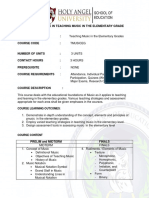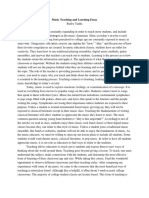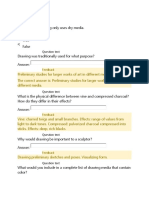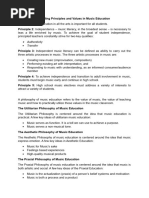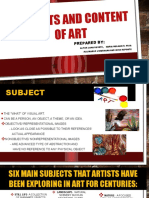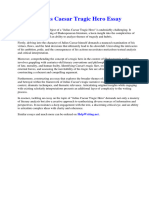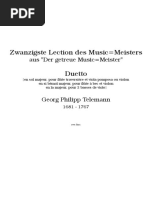History of Music
History of Music
Uploaded by
Sam GeorgeCopyright:
Available Formats
History of Music
History of Music
Uploaded by
Sam GeorgeOriginal Title
Copyright
Available Formats
Share this document
Did you find this document useful?
Is this content inappropriate?
Copyright:
Available Formats
History of Music
History of Music
Uploaded by
Sam GeorgeCopyright:
Available Formats
Origin and History of Music
There are many theories regarding when and where music originated.
Many agree that music began even before man existed. Historiographers
point out that there are 6 periods of music and each period has a
particular style that greatly contributed to what music is today.
Here is a chronological introduction to each stage of music development
to help you better understand the history of music.
Medieval/Middle Ages
The Middle Ages, which encompasses the 6th-century to the 16th-
century, featured Medieval music. This Medieval Music Timeline shows
important events in Medieval music history, such as the beginning of
musical notation and polyphony.
During this time, there were two general types of music styles; the
monophonic and the polyphonic. The main forms of music included
Gregorian chanting and Plainchant. Plainchant is a form of church music
that has no instrumental accompaniment and only involves chanting or
singing. For a period of time, it was the only type of music allowed in
Christian churches.
Around the 14th-century, secular music became increasingly prominent,
setting the stage for the music period known as the Renaissance.
Renaissance
Renaissance means "rebirth". By the 16th-century, the Church's hold of
the arts was weaker. Thus, composers during this period were able to
bring about many changes in the way music was created and perceived.
For example, musicians experimented with cantus firmus, began using
instrumentals more and created more elaborate music forms that
included up to 6 voice parts.
Read the Renaissance Music Timeline to discover more historical
turning points between the 16th and 17th-century, and here is a more
extensive explanation of different Renaissance Music Forms/Styles.
Baroque
The word "baroque" comes from the Italian word "barocco" which
means bizarre. The Baroque period was a time when composers
experimented with form, musical contrasts, styles and instruments. This
period saw the development of opera, instrumental music as well as
other Baroque music forms and styles. Music became homophonic,
meaning a melody would be supported by a harmony.
Prominent instruments featured in Baroque period compositions
included the violin, viola, double bass, harp, and oboe.
The Baroque period in music history refers to the styles of the 17th and
18th-centuries. The High Baroque period lasted from 1700 to 1750,
during which Italian opera was more dramatic and expansive. Learn
about other periods and events of the time with the Baroque Music
Timeline.
Classical
The music forms and styles of the Classical period, which spans from
1750 to 1820, is characterized by simpler melodies and forms such as
the sonatas.
During this time, the middle class had more access to music, not just the
highly educated aristocrats. To reflect this shift, composers wanted to
create music that was less complicated and easier to
understand. The piano was undoubtedly the primary instrument used by
composers during the Classical period.
Browse through this Classical Music Timeline to learn about significant
events of this period, such as when Mozart wrote his first symphony and
when Beethoven was born.
Romantic
Historiographers define the Romantic Music period to be between 1800
to 1900. Music forms of this period used music to tell a story or express
an idea and the expanded on the use of various instruments including
wind instruments. Instruments that were invented or improved upon
during this time included the flute and the saxophone.
Melodies became fuller and more dramatic as Romantics believed in
allowing their imagination and intense emotion to soar through their
works. By the mid-19th-century, folk music became popular among the
Romantics and more emphasis was put on nationalist themes. Learn
about more turning points during the Romantic period with Romantic
Music Timeline.
20th-Century
Music during the 20th-century brought about many innovations on how
music was performed and appreciated. Artists were more willing to
experiment with new music forms and used technology to enhance their
compositions. Early electronic instruments included the dynamophone,
Theremin, and Ondes-Martnot.
20th-century music styles included impressionistic, 12-tone system,
neoclassical, jazz, concert music, serialism, chance music, electronic
music, new Romanticism, and minimalism
You might also like
- MUSIC IN K-12 CURRICULUM: "History of Music (Music Overview) "Document11 pagesMUSIC IN K-12 CURRICULUM: "History of Music (Music Overview) "Zedy Gulles0% (1)
- Aesthetic Education: By: Bennett ReimerDocument11 pagesAesthetic Education: By: Bennett ReimerRuby Jane DuradoNo ratings yet
- Curriculum Concept MapDocument1 pageCurriculum Concept Mapapi-266155292No ratings yet
- Literature Review:: Strategies For Teaching Art To Grade 1& 2Document9 pagesLiterature Review:: Strategies For Teaching Art To Grade 1& 2alia haiderNo ratings yet
- Music StudyDocument57 pagesMusic Studyapi-451567788No ratings yet
- An Instructional Module and Compilation of Resources in EED 113: Teaching Music in Elementary GradesDocument7 pagesAn Instructional Module and Compilation of Resources in EED 113: Teaching Music in Elementary GradesCarla Joy M. MacalintalNo ratings yet
- Lesson Plan Timbre Tone ColourDocument2 pagesLesson Plan Timbre Tone Colourapi-35563960471% (7)
- Profed7 Cm1 Engaged: Classroom Visitor 7. Field Trip and Service Learning 8. Context Curriculum 9. Impact InvestigationDocument9 pagesProfed7 Cm1 Engaged: Classroom Visitor 7. Field Trip and Service Learning 8. Context Curriculum 9. Impact InvestigationAndrea Mae DelimaNo ratings yet
- Teaching Music in ElementaryDocument3 pagesTeaching Music in ElementaryRIZZA JANNE UgalinoNo ratings yet
- Music Vi Long Quiz Fourth Grading With Answer Key 2017-2018Document5 pagesMusic Vi Long Quiz Fourth Grading With Answer Key 2017-2018Arlene DurbanNo ratings yet
- The 21st Century Teacher:: MusicDocument12 pagesThe 21st Century Teacher:: MusicAnalia BetanzoNo ratings yet
- Scope and Sequence of Art 1-6Document15 pagesScope and Sequence of Art 1-6ChenNo ratings yet
- An Aerophone Is Any Musical Instrument That Produces Sound Primarily by Causing A Body of Air To Vibrate Without The Use of Strings or MembranesDocument10 pagesAn Aerophone Is Any Musical Instrument That Produces Sound Primarily by Causing A Body of Air To Vibrate Without The Use of Strings or MembranesZen Loberanes DanosNo ratings yet
- Course Outline in Teaching Music in The Elementary GradeDocument3 pagesCourse Outline in Teaching Music in The Elementary GradeCathy Rebote100% (1)
- Tmusiceg PDFDocument3 pagesTmusiceg PDFGirlie C . BolanosNo ratings yet
- Arts of The Romantic PeriodDocument80 pagesArts of The Romantic PeriodTakukishika Lei-lei RevoltarNo ratings yet
- Lesson 1 Medieval PeriodDocument10 pagesLesson 1 Medieval PeriodJonh Edwel AllocNo ratings yet
- 7 - A7PR Ic e 1Document2 pages7 - A7PR Ic e 1Sarah mae EmbalsadoNo ratings yet
- Chapter Iv Written Report Sir NhorDocument7 pagesChapter Iv Written Report Sir NhorRasmia SamianaNo ratings yet
- Classical Period Composers PresentationDocument17 pagesClassical Period Composers PresentationJess De BarasNo ratings yet
- Romantic Music Pre TestDocument1 pageRomantic Music Pre TestAmiel MaldonadoNo ratings yet
- Module 4 5 and 6 Teaching MethodsDocument18 pagesModule 4 5 and 6 Teaching MethodsJUNALYN ALIGWAYNo ratings yet
- Sample Module MAPEHDocument14 pagesSample Module MAPEHBernard VargasNo ratings yet
- Flexi Learning Toolkit - Understanding MusicDocument64 pagesFlexi Learning Toolkit - Understanding Musicdanaya fabregasNo ratings yet
- Teaching Music in The Elementary GradesDocument6 pagesTeaching Music in The Elementary GradesKenny John SananNo ratings yet
- Vii. Course Syllabus For Ge LWR: The Life and Works of RizalDocument20 pagesVii. Course Syllabus For Ge LWR: The Life and Works of Rizaljoan arreolaNo ratings yet
- Introduction To MusicDocument3 pagesIntroduction To Musicfredlopez09100% (1)
- Music Teaching and Learning EssayDocument3 pagesMusic Teaching and Learning Essayapi-491571575No ratings yet
- Philippine Choral Groups: Jeri-Mei D. Cadiz Bsed Iii - MapehDocument11 pagesPhilippine Choral Groups: Jeri-Mei D. Cadiz Bsed Iii - MapehChano MorenoNo ratings yet
- Detailed Lesson PlanDocument4 pagesDetailed Lesson PlanAlfie CuasitoNo ratings yet
- In Music, Arts Physical Education and Araling Panlipunan: A Musical Dance of MindanaoDocument9 pagesIn Music, Arts Physical Education and Araling Panlipunan: A Musical Dance of MindanaoSharyn EstaNo ratings yet
- Part 14 - Grade 1 Edumate Music LP - Timbre of Orchestral InstrumentsDocument2 pagesPart 14 - Grade 1 Edumate Music LP - Timbre of Orchestral InstrumentsAndrewOribianaNo ratings yet
- DLP MusicDocument5 pagesDLP MusicDizon, Ray-ann Mae, B.No ratings yet
- Topic1teaching Music in The Elementary GradesDocument26 pagesTopic1teaching Music in The Elementary Gradesodessa urgelNo ratings yet
- Philosophy of Art Education Emma AhartDocument2 pagesPhilosophy of Art Education Emma Ahartapi-535738874No ratings yet
- Modified School Forms PrivateDocument13 pagesModified School Forms PrivateShara Faye GalpaoNo ratings yet
- The Socio-Ecological Fractality in Learning Philippine Folk DancesDocument9 pagesThe Socio-Ecological Fractality in Learning Philippine Folk DancesInternational Journal of Innovative Science and Research TechnologyNo ratings yet
- The Teaching & Learning EnvironmentDocument30 pagesThe Teaching & Learning EnvironmentTerry Ann100% (1)
- Minor Scale Lesson PlanDocument7 pagesMinor Scale Lesson PlanThiago André100% (1)
- Lesson 1.1 Digital ArtDocument2 pagesLesson 1.1 Digital Artfemeller l podadorNo ratings yet
- Defining Music From A Sociological Perspective 1Document8 pagesDefining Music From A Sociological Perspective 1bheff004No ratings yet
- Lesson 4 Verdi and The OperaDocument2 pagesLesson 4 Verdi and The OperaPRINTDESK by DanNo ratings yet
- Module 3 Quiz. Answers KeyDocument5 pagesModule 3 Quiz. Answers KeyJovy Ando100% (1)
- DLP ARTS DAY 3 To 5, 2019-2020 Q1Document4 pagesDLP ARTS DAY 3 To 5, 2019-2020 Q1hendrix obcianaNo ratings yet
- Reviewer TTLDocument22 pagesReviewer TTLDindy AnneNo ratings yet
- Semi Detailed Lesson Plan in English - Parts of SpeechDocument2 pagesSemi Detailed Lesson Plan in English - Parts of SpeechDarlene AmadorNo ratings yet
- Disciplinary Foundation of Music EducationDocument10 pagesDisciplinary Foundation of Music EducationChanie Lynn MahinayNo ratings yet
- Five Guiding Principles For Music Education: by Scott C. Shuler, MENC PresidentDocument3 pagesFive Guiding Principles For Music Education: by Scott C. Shuler, MENC PresidentRose Marie BalmoresNo ratings yet
- Drugs of AbuseDocument22 pagesDrugs of AbuseHemantNo ratings yet
- in Music FinalDocument86 pagesin Music FinalDaniella Timbol0% (1)
- Guiding Principles and Values in Music EducationDocument2 pagesGuiding Principles and Values in Music EducationCarol Ann Baltar100% (1)
- Lesson Plan For 1st Demo Teaching in ShsDocument6 pagesLesson Plan For 1st Demo Teaching in ShsMimayNo ratings yet
- Subjects and Contents of ArtDocument19 pagesSubjects and Contents of ArtAerith ScrivensNo ratings yet
- Kodaly MethodDocument27 pagesKodaly MethodStephany ReyesNo ratings yet
- Texture Grade 6 NTOT Part 1 - GRACEEEEDocument48 pagesTexture Grade 6 NTOT Part 1 - GRACEEEEglennbondocNo ratings yet
- Joshua JAMELO - MODULE 2 - RESEARCH ANALYSISDocument2 pagesJoshua JAMELO - MODULE 2 - RESEARCH ANALYSISchicken pork adoboNo ratings yet
- 8 PerennialismDocument15 pages8 PerennialismHabib MasoodNo ratings yet
- 16 - History of MusicDocument5 pages16 - History of MusicAnonymous i7fNNiRqh2No ratings yet
- Renaissance MusicDocument18 pagesRenaissance MusicDiana GhiusNo ratings yet
- Music HistoryDocument6 pagesMusic Historyapi-3807053100% (1)
- Soprano Recorder (Baroque) Fingering Chart: Musical Instrument GuideDocument1 pageSoprano Recorder (Baroque) Fingering Chart: Musical Instrument GuideLance BorjaNo ratings yet
- PURCELL Roche Abdelazer Suite For Strings Continuo ALLDocument82 pagesPURCELL Roche Abdelazer Suite For Strings Continuo ALLAndresNo ratings yet
- Julius Caesar Tragic Hero EssayDocument7 pagesJulius Caesar Tragic Hero Essayxtnzpacaf100% (2)
- Glorious Morning-Score and PartsDocument30 pagesGlorious Morning-Score and PartsNeoNo ratings yet
- Free Sheet Music For BassoonDocument17 pagesFree Sheet Music For BassoonLuís Tasso SantosNo ratings yet
- Gothic Voices - The Spirits of England and France, Vol. 2 PDFDocument25 pagesGothic Voices - The Spirits of England and France, Vol. 2 PDFIsraelNo ratings yet
- Music9 - q1 - Mod1 - Vocal and Instrumental Music of Medieval, Renaissance and Baroque Periods - v3Document20 pagesMusic9 - q1 - Mod1 - Vocal and Instrumental Music of Medieval, Renaissance and Baroque Periods - v3FRANCIS D. SACRO100% (11)
- Words and Music in Communion - An Analysis of Guillaume de Machaut PDFDocument138 pagesWords and Music in Communion - An Analysis of Guillaume de Machaut PDFZuzannaNo ratings yet
- Catalogo Libri Musica Antica Storia Medievale CD Ott 2015 PDFDocument15 pagesCatalogo Libri Musica Antica Storia Medievale CD Ott 2015 PDFSalvatore LambertiNo ratings yet
- Compare and Contrast Essay Sample PaperDocument4 pagesCompare and Contrast Essay Sample Paperafibyrirmfogiz100% (2)
- NhdannotatedbibliographyDocument8 pagesNhdannotatedbibliographyapi-125184866No ratings yet
- Musical Instruments in An Inventory by Andrea Mantova PDFDocument43 pagesMusical Instruments in An Inventory by Andrea Mantova PDFSimon Gonzalez CaceresNo ratings yet
- 9 Music K To 12 MELCS With CG Codes SplitDocument3 pages9 Music K To 12 MELCS With CG Codes SplitJonathan Siriban BiasNo ratings yet
- MAPEH (Music 9)Document2 pagesMAPEH (Music 9)janebau65No ratings yet
- Approach Notes-Enclosure Study PDFDocument2 pagesApproach Notes-Enclosure Study PDFthemisjazzNo ratings yet
- MUSIC-Learning-Plan - MAPEH-1ST QUARTER Week-1-8Document5 pagesMUSIC-Learning-Plan - MAPEH-1ST QUARTER Week-1-8remigioregine169No ratings yet
- Daily Lesson Log Music Week 2Document5 pagesDaily Lesson Log Music Week 2MichelleNo ratings yet
- Gradual (Ps 117:24, 1)Document3 pagesGradual (Ps 117:24, 1)Geraldine AndrianiNo ratings yet
- Class 6 - French and Italian Music in The Fourteenth CenturyDocument3 pagesClass 6 - French and Italian Music in The Fourteenth Centuryisabella perron100% (1)
- AbondanteDocument2 pagesAbondantePaulaRiveroNo ratings yet
- G9-1st PERIODICAL TEST-MAPEH9Document7 pagesG9-1st PERIODICAL TEST-MAPEH9Jayamae Pondolanan SorianoNo ratings yet
- 500 WordDocument1 page500 WordjshdisjNo ratings yet
- Rondeau: Les Barricades Mystérieuses: From "Ordre 6ème de Clavecin", No.5Document3 pagesRondeau: Les Barricades Mystérieuses: From "Ordre 6ème de Clavecin", No.5Javier Galindo Calvo100% (2)
- Ben & Ben Medley: VioloncelloDocument5 pagesBen & Ben Medley: VioloncelloGabArtisanNo ratings yet
- 14th Century Ars Nova. Motet and MassDocument68 pages14th Century Ars Nova. Motet and MassAriana CelesteNo ratings yet
- Tablature With Lute, Traverso & ViolinsDocument93 pagesTablature With Lute, Traverso & Violinst8liskerNo ratings yet
- Análisis Viderunt OmnesDocument16 pagesAnálisis Viderunt OmnesCamila VillalbaNo ratings yet
- IMSLP115551 PMLP235624 Duetto TelemannDocument5 pagesIMSLP115551 PMLP235624 Duetto TelemannNam RamelliniNo ratings yet
- Eras of MusicDocument28 pagesEras of MusicKaylah MatshedisoNo ratings yet
- The Medieval PeriodDocument22 pagesThe Medieval PeriodMathieu François MoutouNo ratings yet








